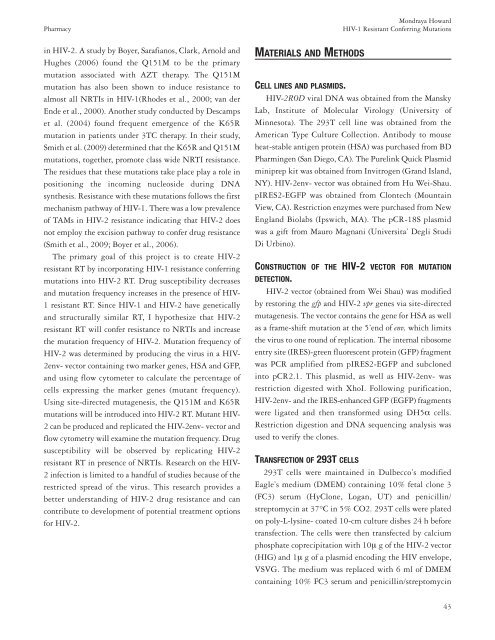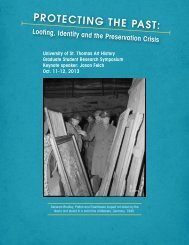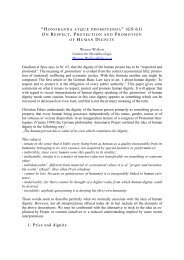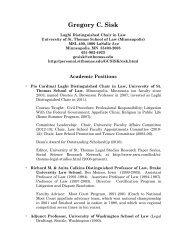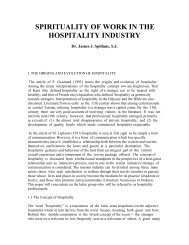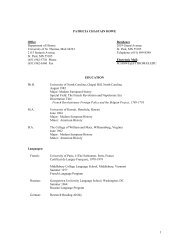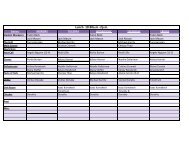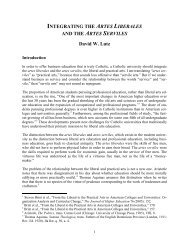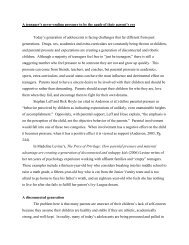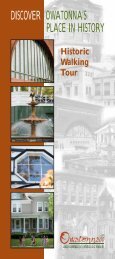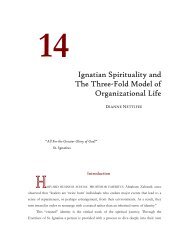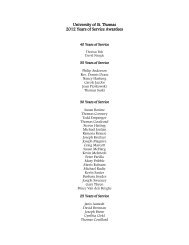dr. ronald e. mcnair acknowledgements - University of St. Thomas
dr. ronald e. mcnair acknowledgements - University of St. Thomas
dr. ronald e. mcnair acknowledgements - University of St. Thomas
Create successful ePaper yourself
Turn your PDF publications into a flip-book with our unique Google optimized e-Paper software.
Mon<strong>dr</strong>aya Howard<br />
Pharmacy HIV-1 Resistant Conferring Mutations<br />
in HIV-2. A study by Boyer, Sarafianos, Clark, Arnold and<br />
Hughes (2006) found the Q151M to be the primary<br />
mutation associated with AZT therapy. The Q151M<br />
mutation has also been shown to induce resistance to<br />
almost all NRTIs in HIV-1(Rhodes et al., 2000; van der<br />
Ende et al., 2000). Another study conducted by Descamps<br />
et al. (2004) found frequent emergence <strong>of</strong> the K65R<br />
mutation in patients under 3TC therapy. In their study,<br />
Smith et al. (2009) determined that the K65R and Q151M<br />
mutations, together, promote class wide NRTI resistance.<br />
The residues that these mutations take place play a role in<br />
positioning the incoming nucleoside during DNA<br />
synthesis. Resistance with these mutations follows the first<br />
mechanism pathway <strong>of</strong> HIV-1. There was a low prevalence<br />
<strong>of</strong> TAMs in HIV-2 resistance indicating that HIV-2 does<br />
not employ the excision pathway to confer <strong>dr</strong>ug resistance<br />
(Smith et al., 2009; Boyer et al., 2006).<br />
The primary goal <strong>of</strong> this project is to create HIV-2<br />
resistant RT by incorporating HIV-1 resistance conferring<br />
mutations into HIV-2 RT. Drug susceptibility decreases<br />
and mutation frequency increases in the presence <strong>of</strong> HIV-<br />
1 resistant RT. Since HIV-1 and HIV-2 have genetically<br />
and structurally similar RT, I hypothesize that HIV-2<br />
resistant RT will confer resistance to NRTIs and increase<br />
the mutation frequency <strong>of</strong> HIV-2. Mutation frequency <strong>of</strong><br />
HIV-2 was determined by producing the virus in a HIV-<br />
2env- vector containing two marker genes, HSA and GFP,<br />
and using flow cytometer to calculate the percentage <strong>of</strong><br />
cells expressing the marker genes (mutant frequency).<br />
Using site-directed mutagenesis, the Q151M and K65R<br />
mutations will be introduced into HIV-2 RT. Mutant HIV-<br />
2 can be produced and replicated the HIV-2env- vector and<br />
flow cytometry will examine the mutation frequency. Drug<br />
susceptibility will be observed by replicating HIV-2<br />
resistant RT in presence <strong>of</strong> NRTIs. Research on the HIV-<br />
2 infection is limited to a handful <strong>of</strong> studies because <strong>of</strong> the<br />
restricted spread <strong>of</strong> the virus. This research provides a<br />
better understanding <strong>of</strong> HIV-2 <strong>dr</strong>ug resistance and can<br />
contribute to development <strong>of</strong> potential treatment options<br />
for HIV-2.<br />
MATERIALS AND METHODS<br />
CELL LINES AND PLASMIDS.<br />
HIV-2ROD viral DNA was obtained from the Mansky<br />
Lab, Institute <strong>of</strong> Molecular Virology (<strong>University</strong> <strong>of</strong><br />
Minnesota). The 293T cell line was obtained from the<br />
American Type Culture Collection. Antibody to mouse<br />
heat-stable antigen protein (HSA) was purchased from BD<br />
Pharmingen (San Diego, CA). The Purelink Quick Plasmid<br />
miniprep kit was obtained from Invitrogen (Grand Island,<br />
NY). HIV-2env- vector was obtained from Hu Wei-Shau.<br />
pIRES2-EGFP was obtained from Clontech (Mountain<br />
View, CA). Restriction enzymes were purchased from New<br />
England Biolabs (Ipswich, MA). The pCR-18S plasmid<br />
was a gift from Mauro Magnani (Universita’ Degli <strong>St</strong>udi<br />
Di Urbino).<br />
CONSTRUCTION OF THE HIV-2 VECTOR FOR MUTATION<br />
DETECTION.<br />
HIV-2 vector (obtained from Wei Shau) was modified<br />
by restoring the gfp and HIV-2 vpr genes via site-directed<br />
mutagenesis. The vector contains the gene for HSA as well<br />
as a frame-shift mutation at the 5’end <strong>of</strong> env, which limits<br />
the virus to one round <strong>of</strong> replication. The internal ribosome<br />
entry site (IRES)-green fluorescent protein (GFP) fragment<br />
was PCR amplified from pIRES2-EGFP and subcloned<br />
into pCR2.1. This plasmid, as well as HIV-2env- was<br />
restriction digested with XhoI. Following purification,<br />
HIV-2env- and the IRES-enhanced GFP (EGFP) fragments<br />
were ligated and then transformed using DH5α cells.<br />
Restriction digestion and DNA sequencing analysis was<br />
used to verify the clones.<br />
TRANSFECTION OF 293T CELLS<br />
293T cells were maintained in Dulbecco’s modified<br />
Eagle’s medium (DMEM) containing 10% fetal clone 3<br />
(FC3) serum (HyClone, Logan, UT) and penicillin/<br />
streptomycin at 37°C in 5% CO2. 293T cells were plated<br />
on poly-L-lysine- coated 10-cm culture dishes 24 h before<br />
transfection. The cells were then transfected by calcium<br />
phosphate coprecipitation with 10m g <strong>of</strong> the HIV-2 vector<br />
(HIG) and 1m g <strong>of</strong> a plasmid encoding the HIV envelope,<br />
VSVG. The medium was replaced with 6 ml <strong>of</strong> DMEM<br />
containing 10% FC3 serum and penicillin/streptomycin<br />
43


